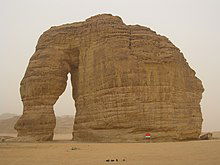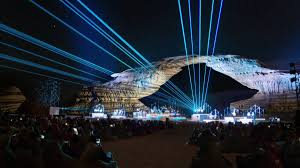Al-Ula is one of the cities of the Kingdom of Saudi Arabia. It is located in the northwest of the Kingdom. It is administratively affiliated with the Emirate of the Medina region. It is approximately 300 kilometers north of the center of the emirate, and it is the capital of Al-Ula Governorate. The age of human settlement there is about 4,000 years, and it is one of the most important tourist destinations in Saudi Arabia. Yaqut al-Hamwi mentioned Al-Ula in his dictionary, with the first word included, and Al-Qasr, which is the plural of Al-Ula, and it is the name of a place on the side of Wadi Al-Qura between it and the Levant, where the Prophet Muhammad, may God bless him and grant him peace, descended on his way to the Battle of Tabuk, and designated there a place for a mosque whose borders he marked with bones, so its people built it. After that, they called it the Mosque of Bones. In the past, it was called Dadan, and it is said that the reason for calling it Al-Ula was that it had two well-known springs with fresh water, namely Al-Mu’alliq and Tadala, and at the source of Al-Mu’alliq were high-rise palm trees called Al-Ali. The city of Al-Ula is located between two large mountains on a valley with fertile soil, where palms, citrus fruits, and fruits are grown. Groundwater is available at close distances despite the great scarcity of rain. It is among the archaeological sites registered with UNESCO. It is the second capital of the Nabataeans in ancient times, and its climate is continental, hot in summer and cold in winter. It is followed by approximately 300 villages.

Geographical locationThe city of Al-Ula is located between mountainous heights bordering it to the east and west, from which it extends to the south. Al-Ula is connected to the surrounding cities by agricultural roads, as it is approximately 300 km from Medina, 200 km from Al-Wajh, 250 km from Tabuk, approximately 400 km from Hail, 200 km from Khaybar, and 90 km from Al-Jahra. Directly north of the city of Al-Ula are the Al-Hijr ruins, also known as Mada’in Saleh. They are monuments dating back to the civilization of the Nabataeans, the people of God’s Prophet Saleh. The most famous of them are the houses that they used to dig in the rocks, and many Muslims believe that they are the site of the story of the destruction of Thamud that was mentioned in the Qur’an. The Hejar area is located on an expansive area of naturally open monuments that has been registered with UNESCO, and there is an old station for the Hejaz Railway built by the Ottoman Empire near it. Al-Ula is known as the Bride of the Mountains and the capital of history and antiquities due to its mountainous scenery, its height more than 700 meters above sea level, its ancient history, and its many archaeological sites. Researchers have discovered the remains of temples and statues dating back to the Lihyanite era in 900 BC. Civilizations have succeeded one another due to the fertility of the land and the abundance of water.

Why the name Al-Ula?Al-Ula was called several names before settling on its current name. In the sixth century BC, it was called Dedanite, after the Dedanite people who settled there and established a kingdom there. In the pre-Islamic era, it was known as Qarh during its activity as an important commercial market for the Arabs. In a later period, until the end of the sixth century AH, it was called Wadi Al-Qura because of the large number of villages in it. Starting from the seventh century AH, it was given its name today, Al-Ula. It is said that it was called that since the second century AH, but the popularity of the name was delayed until the seventh century.

Tantora Winter Festival
It is an annual event in Al-Ula Governorate in which the people celebrate and exchange congratulations on their return to the fields, the return of the agricultural season, and the onset of winter. It was named Tantora after the sundial located in the southeastern part of the village, as the people of the region relied on it to know the time of the beginning of the agricultural season and the change of the seasons of the year. The festival includes entertainment, cultural and sports activities and provides field visits to archaeological sites in the region. The activities included 13 archaeological and cultural sites, in addition to musical theatrical performances included by the Maraya Theater in the city. Wadi Al-Qura is considered a favorite because of the large number of villages there. Starting from the seventh century AH, it was given its name today, Al-Ula. It is said that it was called that since the second century AH, but the popularity of the name was delayed until the seventh century.
